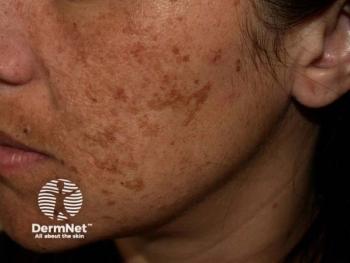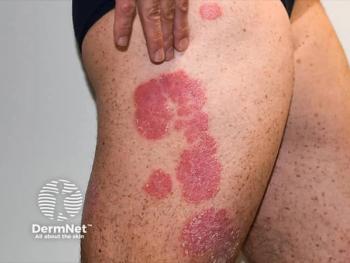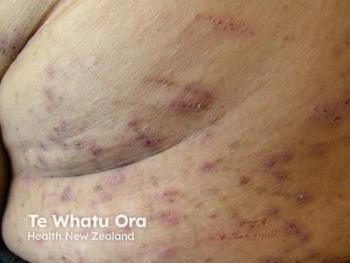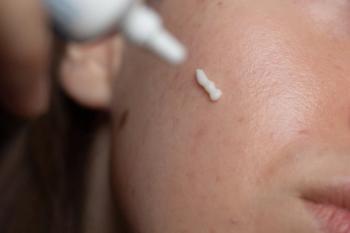
Addressing Cutaneous Squamous Cell Carcinoma Through Early Detection and Treatment
Key Takeaways
- Early biopsy and high suspicion for malignancy are crucial in non-resolving or atypical skin lesions, even in young patients without classic risk factors.
- Genetic workups and early intervention are vital in managing aggressive cutaneous squamous cell carcinoma, as demonstrated by a case of a young female patient.
A poster at SDPA 2025 highlights the importance of early biopsy and genetic testing in aggressive cSCC, even in young patients without classic risk factors.
A poster presented at the 2025 Society of Dermatology Physician Associates (SDPA) Annual Summer Dermatology Conference in Washington, DC, highlighted the importance of completing genetic workups and engaging in early intervention in cutaneous squamous cell carcinoma (cSCC).1
Sarah Anderson, MPAS, PA-C, of River Ridge Dermatology in Virginia, authored the poster, which outlined the case of a 22-year-old female patient with an aggressive case of cSCC.
The young woman presented with concerns about a lesion on her cheek. Prior clinical evaluation conducted by another provider led to a tentative diagnosis of benign furuncle. Retrospective analyses have identified common misdiagnoses of cutaneous malignant tumors, with research published in Clinical, Cosmetic and Investigational Dermatology reporting that cSCC, basal cell carcinoma, and malignant melanoma are often first misdiagnosed as melanocytic nevi or seborrheic keratosis.2
The patient reported that the other clinician who examined the lesion approached treatment conservatively with systemic antibiotics, and, lacking resolution, she sought a second opinion.
Analysis of the lesion via histopathological evaluation led to a diagnoses of differentiated cSCC. Following Mohs micrographic surgery, clinicians observed the lesion exhibited perineural invasion of 6 mm or greater. Additional imaging led to the discovery of bilateral node invasion, and clinicians referred the patient to specialists in oncology; ear, nose, and throat; and genetics.
Treatment with adjuvant radiation therapy led to complete removal of the lesion and healing of the skin, without any observed complications. Genetic testing results did not yield a specific cause, but did point toward multifactorial predisposition.
As of the time of the poster's authoring, the patient has not experienced recurrence or metastasis.
"This case underscores the critical importance of early biopsy in non-resolving or atypical skin lesions and the necessity of maintaining a high index of suspicion for malignancy even in young patients who may not present with classic risk factors," wrote Anderson.1 "It also emphasizes the necessity for thorough re-evaluation of new patients."
The poster also called for early genetic testing in young patients presenting to the clinic with aggressive forms of skin cancer, noting that "Early diagnosis, definitive surgical management, and vigilant follow-up are vital for optimal outcomes."
In early detection of neoplasms, population-based screening is critical, wrote authors of a study published in Cancers.3 Stătescu et al recommend oncological screening for patients at a high-risk of skin cancers, as well as in case of early-diagnosis cutaneous neoplasms and cutaneous paraneoplastic disorders.
References
- Anderson S. Aggressive cutaneous squamous cell carcinoma in a young adult: a case highlighting the role of genetic workup and early intervention. Poster presented at: Society of Dermatology Physician Associates (SDPA) 2025 Annual Summer Dermatology Conference; June 26-29, 2025; Washington, DC.
- Zhang J, Wang Y, Zhang W, et al. Clinical misdiagnosis of cutaneous malignant tumors as melanocytic nevi or seborrheic keratosis: a retrospective analysis of a Chinese population. Clin Cosmet Investig Dermatol. 2024;17:465-476. Published 2024 Feb 26.
doi:10.2147/CCID.S451288 - Stătescu L, Cojocaru E, Trandafir LM, et al. Catching cancer early: the importance of dermato-oncology screening. Cancers (Basel). 2023;15(12):3066. Published 2023 Jun 6.
doi:10.3390/cancers15123066
Make sure to keep up to date with the latest in coverage from the conference and subscribe to Dermatology Times to receive daily email updates .
Newsletter
Like what you’re reading? Subscribe to Dermatology Times for weekly updates on therapies, innovations, and real-world practice tips.


















